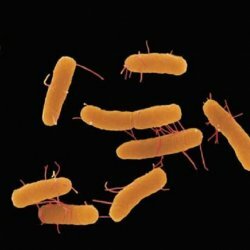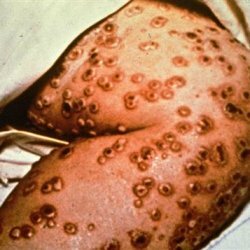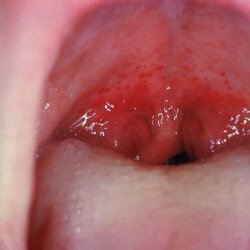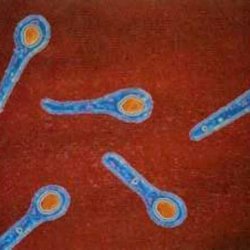Salmonellosis - "disease of raw eggs"
Salmonellosis, also called "disease of raw eggs," is an acute infectious disease. This disease, which is characterized by a variety of clinical manifestations, is mainly characterized by gastrointestinal symptoms as inflammatory diseases of the stomach, small and large intestines. The entire given gastrointestinal "kaleidoscope" subsequently causes intoxication, as well as dehydration and attachment of other clinical "surprises".
 The causative agent of salmonellosis
The causative agent of salmonellosis
Salmonellosis is caused by a large group of bacteria belonging to the Salmonella family. These representatives of the microcosm are very tenacious. For salmonella, meat and dairy products of various kinds serve as an ideal medium, but in particular they are raw eggs, where the bacterium can not only exist, but also multiply rapidly, creating whole colonies. The taste and consistency of the products does not change at all. Smoking and salting in this case does not save the situation.
What are the causes of salmonellosis
? The person is very susceptible to salmonella invasion. The carriers of salmonella are animals. It can be wild animals, birds, or pets, in most cases pigs, also cattle. Recently, salmonellosis has become popular among chickens. In the bird's litter Salmonella feel particularly good, the ubiquity of the spread of which this substance makes extremely contagious. And infection occurs on farms when caring for animals, when slaughtering livestock at various meat processing plants, when eating contaminated meat, dairy products and eggs. Also, beware of their pets, as up to 10% of dogs and cats are considered carriers of salmonella.
People can also be a source of infection, and especially in hospital settings. A person can wear a secret salmonella within 1 year. Salmonellosis is an increased threat to children under the age of one year, since this period is marked by a high susceptibility to salmonella.
The method of transmission of salmonellosis is considered fecal-oral. If you broke an egg, and the smell of it seems suspicious to you, then it's better not to tempt fate. Vegetable products and fish in this case are safer. It is also possible to contact the path of infection in a domestic environment, for example, through common objects, nursing and parental hands, children's toys, night pots, through medical devices. And another invasive known factor is dust containing elements of the litter of infected birds.
Unlike some intestinal infections, salmonellosis can not be considered a "village" disease: it occurs in most cases in large cities.
What are the symptoms of salmonellosis
It is revealed that there are several forms of this disease. It is gastrointestinal( when the stomach is involved), also gastroenterocolitis( large intestine) and gastroenteric( small intestine) variant. Still generalized, which is represented by typhoid-like and septic variants.
Salmonella is the most common gastroenteric variant. The illness begins to manifest itself quickly, even several hours after the invasion of the infection: the temperature increases, the aches and chills in the body are felt, the head hurts. After the abdominal pain( near the navel and under the pit of the stomach), nausea, and unrestrained vomiting are added to this. There is diarrhea, and with the transition from the already designed chair to foaming, watery green feces. The expected diuresis is expected. There is also a bloating with a slight pain on palpation.
The gastroenterocolitis variant at first does not differ from the gastroenteric variant. Its peculiarity begins to appear on day 2-3, when simultaneously with the decrease in the volume of feces, mucus and blood begin to be detected in the latter. When probing the abdomen soreness is localized in the region of the large intestine. There may be false urge to defecate with severe soreness.
Relatively rare gastritis variant of the disease. From the previous two, there is no diarrhea. And all the rest - pain in the abdomen, vomiting, and sharp onset - on the spot. In this case, the course of the disease is more favorable.
Generalized salmonellosis is a typhoid-like variant, which is similar to typhoid fever. This acute intoxication, vomiting, fever, diarrhea, retardation, rash and bloating, apathy. With this option it is better not to collide: by gravity, he "zashnut" all the previous ones. It begins like typhus. This variant of the disease does not lend itself to antibacterial therapy. Foci of sepsis are formed everywhere, in bones and joints, in the heart muscle, the aorta, in the brain.
What is the treatment of salmonellosis
In hospital conditions, salmonellosis treatment is provided only in the presence of complications. When a high degree of intoxication, as well as dehydration( dehydration), the patient must not leave the bed.
Begin treatment of the disease from the gastrointestinal lavage, with the appointment of enterosorbents( activated charcoal, enterodez, polysorb).
Depending on the dehydration, 3( sometimes 4) degrees of dehydration are isolated. If salmonellosis is accompanied by 1-2 degrees of dehydration, in this case doctors prescribe water-salt solutions along with glucose like hydrovit, regidron, glucosolana. Take solutions inside often enough and in small portions. And with dehydration of the third degree, intravenous jet injection of crystalline polyionic solutions( quartz, trisol) is always shown.
Already after the correction of the water-electrolyte balance has been completed, various detoxification measures can be carried out by the method of introducing haemodes, rheopolyglucin and other macromolecular colloidal preparations.
And with the gastrointestinal form of salmonellosis, antibiotics are usually not prescribed. Only with generalized forms of the disease is it appropriate to take ciprofloxacin, fluoroquinolones, levomycetin or doxycycline.
In salmonellosis, eubiotics( baktisubtil, linex, bioflora), enzyme preparations( festal, mezim), spasmolytics( no-shpa) are prescribed as auxiliary agents.



